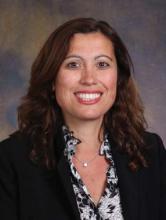CHICAGO – Women aged 40-49 years with and without a family history of breast cancer had virtually the same rates of invasive disease in a retrospective analysis of data on more than 1,000 patients diagnosed over a 10-year period at a single site.
The finding adds weight to the American Cancer Society’s recommendation in favor of annual screening mammograms for women beginning at age 40, said principal author Dr. Stamatia V. Destounis of Elizabeth Wende Breast Care LLC in Rochester, N.Y. Dr. Destounis presented the results of her study in a press briefing at the annual meeting of the Radiological Society of North America.
A study presented at last year’s meeting by researchers at the London Breast Institute of the Princess Grace Hospital indicated that annual mammograms could reduce by half the risk of mastectomy in women who were diagnosed with breast cancer between the ages of 40 and 50 years.
Both studies challenge the recommendation against routine annual mammography for women under the age of 50 made in 2009 by the United States Preventive Services Task Force.
"These conflicting recommendations have led to confusion among patients and physicians," Dr. Destounis said.
In the present study, Dr. Destounis and her colleagues analyzed data on women between the ages of 40 and 49 years who underwent screening mammography at the center between 2000 and 2010.
In all, 1,116 cancers were found in 1,071 patients aged 40-49 years. Of these patients, 373 were diagnosed by screening mammography. Of these 373 women, 144 (39%) had a family history of breast cancer, 228 (61%) did not, and 1 patient did not know her family history. (A total of 7 patients with and 16 patients without a family history of breast cancer also had a personal history of breast cancer.)
Among women with a family history, 32% (46) had a first-degree relative with a premenopausal history, 38% (54) had a first-degree relative with a postmenopausal history, and 31% (44) had a second- or third-degree relative with a pre- or postmenopausal history of the disease.
The incidence of invasive breast cancer was virtually the same – 63% (91) and 64% (146), respectively – in women with and without a family history. The incidence of noninvasive disease in the two groups was also similar, at 37% and 36%, respectively. Those with and without a family history shared similar rates of lymph node metastatic disease (31% and 29%) as well.
"Family history does not seem to [affect] the rate of invasive disease in our patient cohort," Dr. Destounis said.
The following types of lesions were found in women with and without a family history, respectively: mass (42, 86), microcalcification (69, 97), mass with calcification (21, 18), architectural distortion (11, 18), and asymmetry (1, 9).
All 144 patients with a family history and 227 of 228 patients in the no family history group proceeded to surgery. One patient had metastatic disease and opted for no surgery or treatment.
Among women with and without a family history, 63% and 68%, respectively, underwent a lumpectomy. Some of these patients did not have clear margins after surgery and went on to mastectomy. In all, 38% (54) of women with a family history and 31% (71) women without a family history went on to mastectomy.
Since no difference in the rate of invasive breast cancer between women with and without a family history was found in this population, "the recommendation should be that women in their 40s have a screening mammogram yearly," she said.
Dr. Destounis and her colleagues are currently collecting additional data on breast density, demographics, and survival rates for this patient group.
Dr. Destounis disclosed that she has been an investigator for Siemens AG, Fujifilm Holdings, Hologic Inc., and Koning Corp. She has also served as an advisory board member for Philips Electronics and Matakina International Ltd.

